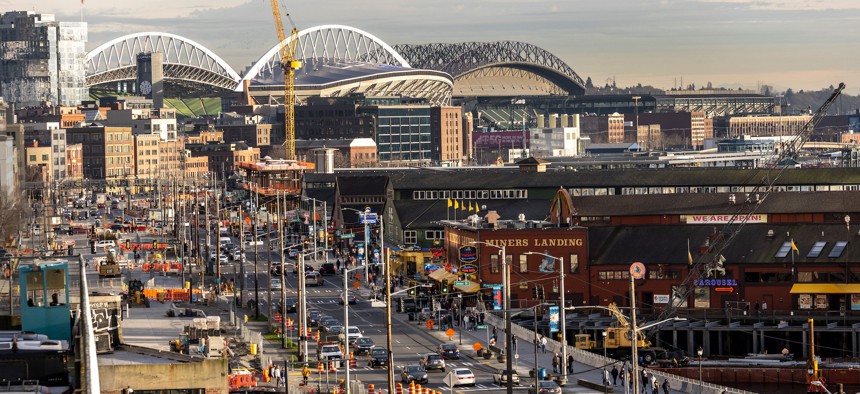A Few Cities Are Regaining Residents After Shrinking During the Pandemic

Seattle is one of several cities that lost population between 2020 and 2021 but now have more people than they did a decade. John Moore/Getty Images
Seattle, Houston and Atlanta are among the cities that have rallied.
This story was first published by Stateline. Read the original article here.
The vast majority of American cities are shrinking, but new data shows that a few are regaining residents after population declines early in the pandemic—bolstered, perhaps, by the rapid construction of new homes.
Seattle, Houston, Atlanta and Tucson, Arizona, are among the cities that lost population between 2020 and 2021 but now have more people than they did a decade ago, according to a Stateline analysis of city population estimates to be released Thursday by the U.S. Census Bureau.
Only about 631 of the 9,344 cities that lost population early in the pandemic, or 7%, have made such a turnaround. In many of them, the construction of new homes is adding to the housing supply.
But even those cities eking out population increases are fighting an uphill battle on housing shortages. Last year 19 states had rental vacancy rates below 5%, considered an indicator of an extreme housing shortage.
Seattle gained almost 18,000 people between 2021 and 2022, more than overcoming a loss of about 5,500 people between 2020 and 2021.
Separate state estimates show that Seattle’s population is increasing faster than it is in the city’s suburbs, an unusual pattern as white-collar workers who can work remotely are leaving many U.S. cities in search of larger and less expensive homes in the suburbs. Housing costs and remote work have driven some families out of Washington state and into neighboring Idaho.
Seattle added more than 11,000 new housing units between 2021 and 2022, a 27% increase from the year before. But that’s not enough to solve its housing shortage, said Mike Mohrman, a population program manager for the Washington state Office of Financial Management.
“There have been a lot of initiatives by the state to make housing more affordable. Despite this increase in Seattle, housing is in short supply even there,” Mohrman said. Washington state will need more than a million new homes in the next 20 years, more than 50,000 a year, to keep up with demand, according to a state report issued in March.
In Arizona, a bipartisan committee of legislators visited Tucson this past fall to study the housing shortage there. Tucson lost about 1,400 people between 2020 and 2021, but it gained about 5,300 between 2021 and 2022, to notch a net increase for the decade.
Tucson last year extended incentives for more multifamily housing in downtown areas and is now considering more changes to allow denser development like townhomes.
Georgia, which until recently built population based on housing affordability, now faces a housing shortage with 65 would-be buyers for every home on the market, Georgia Chamber of Commerce President Chris Clark wrote in a recent editorial. Atlanta was able to add about 6,500 new residents between 2021 and 2022, canceling a loss of about 6,000 people the previous year. Mayor Andre Dickens, who took office last year, made more housing a campaign promise.
Some other cities, such as Dallas, San Diego and Nashville, Tennessee, gained population between 2021 and 2022 but have yet to overcome larger population losses between 2020 and 2021.
Los Angeles continued to lose population but two of its suburban cities, Irvine and Riverside, racked up big population gains after losing people between 2020 and 2021.
According to Thursday’s census estimates, 40% of U.S. cities lost population between 2020 and 2021, and 2021 and 2022. Twenty-five percent gained population between 2020 and 2021 only to lose population between 2021 and 2022.
Some of the nation’s largest cities are still losing population: New York City has lost almost 470,000 people in two years, even as it looks to convert empty office buildings to apartments. Chicago, Los Angeles and San Francisco also have lost more than 50,000 people since 2020.
Only four U.S. cities have gained more than 25,000 people over the past two years: San Antonio (about 38,500), Fort Worth, Texas (37,800), Phoenix (36,200) and Port St. Lucie, Florida (27,000).





